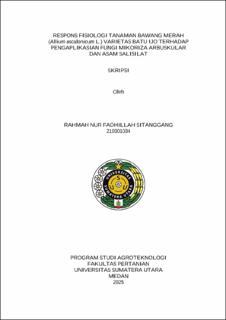Respons Fisiologi Tanaman Bawang Merah (Allium ascalonicum L.) Varietas Batu Ijo Terhadap Pengaplikasian Fungi Mikoriza Arbuskular dan Asam Salisilat
Physiological Response of Shallots (Allium ascalonicum L.) Batu Ijo Variety to the Application of Arbuscular Mycorrhizal Fungi and Salicylic Acid

Date
2025Author
Sitanggang, Rahmah Nur Fadhillah
Advisor(s)
Rahmawati, Nini
Metadata
Show full item recordAbstract
Shallots are horticultural plants that have high nutritional and antioxidant content. Low shallot production is not comparable to increased consumption due to limited irrigation which causes plant responses to water shortages to reduce physiological and morphological aspects of plants. This study aims to analyze the physiological characteristics of Batu Ijo variety shallots to the application of arbuscular mycorrhizal fungi and salicylic acid in conditions below optimal water content in the soil. This research was conducted at the Biotechnology Laboratory, Faculty of Agriculture and the Plant Disease Laboratory, Faculty of Agriculture, University of North Sumatra from October 2024 to February 2025. This study used a Factorial Randomized Complite Block Design (RCBD) consisting of 2 treatment factors with 3 replications. The first factor is the application of arbuscular mycorrhizal fungi (0 g; 10 g). The second factor is the application of salicylic acid (0 mg/L; 25 mg/L; 50 mg/L; 75 mg/L). The results showed that the application of arbuscular mycorrhizal fungi at a dose of 10 g significantly increased the superoxide dismutase (SOD) enzyme. The application of salicylic acid at a concentration of 50 mg/L significantly affected the relative water content (RAC) of leaves. The interaction of the application of arbuscular mycorrhizal fungi with salicylic acid had no significant effect on all observed variables.
Collections
- Undergraduate Theses [3568]
